As we enter 2024, businesses of all shapes and sizes will be keen to maximise their e-commerce opportunities and solve any issues niggling away at their conversion. To this end, we spoke to our friends at CUX to get their top 5 recommendations on what businesses should do to set themselves up for success this year.
Navigating the complex landscape of e-commerce requires more than just data; it demands a strategic approach that aligns with real-life scenarios. Here’s your comprehensive guide to streamlining e-commerce success, backed by data insights from the field.
Set Clear Goals:
Imagine the buzz of a bustling Black Friday sale, where your team is geared up for record-breaking sales. However, a closer examination of the data reveals a discrepancy – the conversion rate lags behind expectations. Enter CUX, a tool that allows you to focus on specific traffic sections. Set goals beyond mere sales, incorporating abandoned cart recovery, event registrations, and more. This ensures targeted analysis, enabling you to identify and address areas hindering conversions.
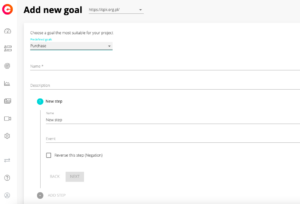
Unlike its competitors, CUX focuses on interpreting data in the context of a business goal. The tool selects only the data and visit recordings that will be important for increasing conversions or preventing their declines.
TIP: If your store was created on the Shoper platform, you can use the automatic analytics option. CUX independently configures ready-made analytical goals presenting the most significant events on the customer journey.
Map Customer Journeys:
Picture a customer navigating your site through a social media ad, expecting a seamless journey. Now, envision a scenario where they get lost along the way. With CUX, you can visualise conversion funnels, pinpointing areas causing drop-offs. Consider this real-life insight: when promoting a group of products, filtering them for the customer can significantly optimise the conversion process. CUX empowers you to enhance the overall shopping experience, ensuring a smoother path to purchase.
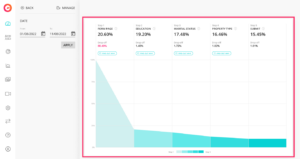
CUX allows you to analyze extensive conversion funnels based on any event. Conversion Waterfall will only show you visits that follow the path you designed. You will also gain access to recordings of visits to each drop to quickly spot errors and places that cause user frustration.
TIP: The order of steps you set in Conversion Waterfall matters!
Track Frustrations with Experience Metrics:
Imagine a shopper on a shoe store’s website – they open multiple tabs, compare options, and seek advice. Real-life insight tells us that customers rarely follow a linear path to purchase. CUX’s Experience Metrics are designed to identify distractions such as flashy graphics and understand repetitive behaviors. By eliminating these frustrations, you can keep customers engaged and guide them along the conversion path seamlessly.
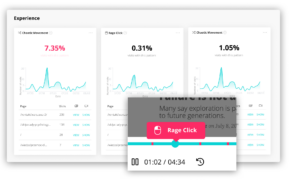
TIP: The CUX algorithm detects and defines user behaviours that may reduce conversions. Experience Metrics include such repetitive behaviours as: rage clicks, rage key presses, zooming, refreshing, bounce backs and chaotic scrolling mouse movements.
Analyse Behaviour with Recordings + Heatmaps:
Consider a scenario where your e-commerce business experiences a sudden spike in paid carts, signalling a period of growth. But, is quantitative success the whole story? Real-life insight teaches us that focusing solely on quantitative analysis may not provide the complete picture. Combine it with qualitative analysis using CUX. Dive into visit recordings, analyse heatmaps, and visualise customer experiences. Understand customer behaviour to optimise advertising campaigns and uncover opportunities for enhancement.
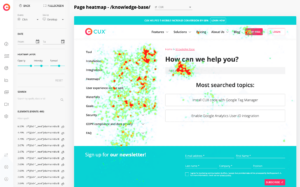
Recordings of visits – filtered for specific purposes – and heatmaps will allow you to visualise customer experiences. You will see places that cause frustration, find room for optimisation, check the effectiveness of advertising campaigns, etc.
TIP: Remember that analysing the recordings will allow you to spot repeated behaviour patterns, so always start from general to specific. When working with heatmaps, take into account those for which at least 250 events to be able to consider the analysis results as reliable.
Stop Saving Baskets:
Abandoned carts – a common cause of anxiety for e-commerce specialists. But consider this: users might not always abandon their carts. Real-life insight tells us that some users make a purchase on their first visit, while others take multiple visits. Before launching retargeting campaigns, analyze real abandonments. CUX helps you determine the average visits needed for a purchase, aligning your strategy with the diverse shopping habits of your customers.
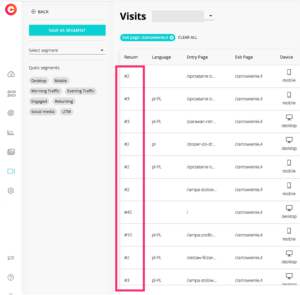
TIP: The first step of your analysis should be to determine how many visits to the website users need on average to make a purchase and what the exit page is. If it’s the checkout itself — without a started payment — you have nothing to worry about. Customers very often add products to their cart for comparison, check whether they will receive a discount, what the delivery cost will be, etc.
Serious about e-commerce success? Embrace analytical tools like CUX for observing user behaviour, applying real-life insights to shape your strategy. Behavioural analysis isn’t just a trend; it’s a crucial stage in shaping the future of your e-business. Elevate your e-store with informed decisions, armed with real-life scenarios to unlock the full potential of your data!

